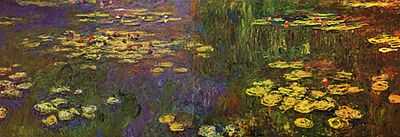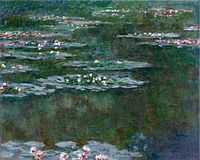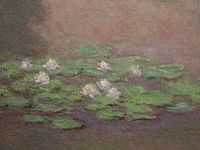Water Lilies



Water Lilies (or Nymphéas, pronounced: [nɛ̃.fe.a]) is a series of approximately 250 oil paintings by French Impressionist Claude Monet (1840–1926). The paintings depict Monet's flower garden at Giverny and were the main focus of Monet's artistic production during the last thirty years of his life. Many of the works were painted while Monet suffered from cataracts.[1]
The paintings are on display at museums all over the world, including the Musée Marmottan Monet[2] and the musée d'Orsay in Paris, the Metropolitan Museum of Art in New York,[3] the Art Institute of Chicago,[4] the Saint Louis Art Museum,[5] the Nelson-Atkins Museum of Art in Kansas City, Missouri,[6] the Carnegie Museum of Art, the National Museum of Wales, the Musée des Beaux-Arts de Nantes, the Cleveland Museum of Art,[7] the Portland Art Museum and the Legion of Honor[8]. During the 1920s, the state of France built a pair of oval rooms at the Musée de l'Orangerie as a permanent home for eight water lily murals by Monet. The exhibit opened to the public on 16 May 1927, a few months after Monet's death.[1] Sixty water lily paintings from around the world were assembled for a special exhibition at the Musée de l'Orangerie in 1999.[9]
On 19 June 2007, one of Monet's water lily paintings sold for £18.5 million at a Sotheby's auction in London.[10] On 24 June 2008 another of Monet's water lily paintings, Le bassin aux nymphéas, sold for almost £41 million at Christie's in London, almost double the estimate of £18 to £24 million.[11]
Monet's career long serial motif of producing and exhibiting a series of paintings related by subject and perspective began in 1889, with at least ten paintings done at the Valley of the Creuse, which were shown at the Galerie Georges Petit.[12] Among his other famous series are his Haystacks.
In May 2010, it was announced that the 1906 Nymphéas work would be auctioned in London in June 2010, the painting had an estimated sale price of between £30 and £40 million.[13] Giovanna Bertazzoni, Christie's auction house director and head of impressionist and modern art, said "Claude Monet's water-lily paintings are amongst the most recognised and celebrated works of the 20th Century and were hugely influential to many of the following generations of artists".[13] The sale took place on 23 June 2010 at the auction house and the painting attracted bids of up to £29 million, but it ultimately failed to sell.[14]
Gallery
-

Water Lilies, 1920–1926, Musée de l'Orangerie
-

Water-Lily Pond, c.1915–1926, Chichu Art Museum, Naoshima, Kagawa, Japan
-

Wisteria, 1925, Gemeentemuseum Den Haag
-

Water Lilies, 1922, Toledo Museum of Art
-

Le Bassin Aux Nymphéas, 1919
-

Water Lilies, 1919, Metropolitan Museum of Art, New York City
-

The Water Lily Pond, c. 1917-19, Albertina
-
Water Lilies, 1917–1919, Honolulu Museum of Art
-
Water-Lily Pond and Weeping Willow, (1916–19)
-

Nymphéas reflets de saule (1916–19), Musée Marmottan Monet
-

Blue Water Lilies, 1916-1919, Musée d'Orsay
-

Sea-Roses (Yellow Nirwana), after 1916, National Gallery, London[1]
-

Nymphéas, 1916, Musée Marmottan Monet
-

Claude Monet, Water Lilies, 1916, National Museum of Western Art, Tokyo[2]
-

White and yellow Water Lilies, (1915–1917), Kunstmuseum Winterthur, Winterthur, Switzerland
-

Nymphéas, 1915, Musée Marmottan Monet
-
_-_Google_Art_Project.jpg)
Nymphéas (Waterlilies), 1914-1917, National Gallery of Australia
-

Water-Lilies, 1914–1917, Toledo Museum of Art
-

Nymphéas, 1915, Neue Pinakothek, Munich
-
.jpg)
Water Lilies (TFAM), 1908, Tokyo Fuji Art Museum
-

Water Lily Pond, 1908
-

Water-Lilies, 1908, Dallas Museum of Arts
-
Water Lilies, 1907 The Museum of Fine Arts, Houston
-
.jpg)
Water Lilies, 1907, Bridgestone Museum of Art, Tokyo
-

Pond with Water Lilies, 1907, Israel Museum
-

Water Lilies, 1906, Art Institute of Chicago
-

Le Bassin des Nympheas, 1904, Denver Art Museum
-

Water Lilies, 1904
-

Water Lilies, 1903, Dayton Art Institute, Dayton, Ohio
-

Closeup of Water lily pond, one of 18 views of the pond, 1899, Boston Museum of Fine Arts
-
.jpg)
Water lilies, 1897–1899, Galleria Nazionale d'Arte Moderna
-

Claude Monet, Nympheas, 1897–1898, Los Angeles County Museum of Art
Cite error: There are <ref> tags on this page, but the references will not show without a {{reflist}} template (see the help page).
Notes
- ↑ 1.0 1.1 "Monet, Claude." Grove Art Online.
- ↑ Claude Monet paintings at the Marmottan
- ↑ Water Lilies at the Metropolitan Museum of Art,
- ↑ Water Lilies at the Art Institute of Chicago
- ↑ Water Lilies at the Saint Louis Art Museum,
- ↑ Water Lilies, the Nelson-Atkins Museum of Art
- ↑ "Water Lilies (Agapanthus)". Cleveland Museum of Art. Retrieved 2013-01-31.
- ↑
- ↑ Susan Bell. "Paris sees Monet lilies in a new light." The Times. 8 May 1999.
- ↑ Dalya Alberge. "Monet lilies make £18.5m but just miss world record." The Times. 20 June 2007.
- ↑ The Laura Henry Collection "Monet masterpiece sells at auction for almost £41million" The Laura Henry Collection. 25 June 2008.
- ↑ Tucker, Paul Hayes, Monet in the '90s: The Series Paintings, 1989, Museum of Fine Arts, Boston in association with Yale University Press , p.41.
- ↑ 13.0 13.1 "Monet water lily to be auctioned at Christie's". BBC News (BBC). 3 June 2010. Retrieved 3 June 2010.
- ↑ "Picasso reaches £34.7m in Christie's auction". BBC News (BBC). 24 June 2010. Retrieved 26 June 2010.
External links
| Wikimedia Commons has media related to Water Lilies by Claude Monet. |
|
|
- Water Lilies at the Portland Art Museum
- "Musical Qualities of Water Lilies, a colored music score transcribed on canvas" by Gabrielle Thierry
- Monet's Years at Giverny: Beyond Impressionism, exhibition catalog fully online as PDF from The Metropolitan Museum of Art, which contains material on these works



